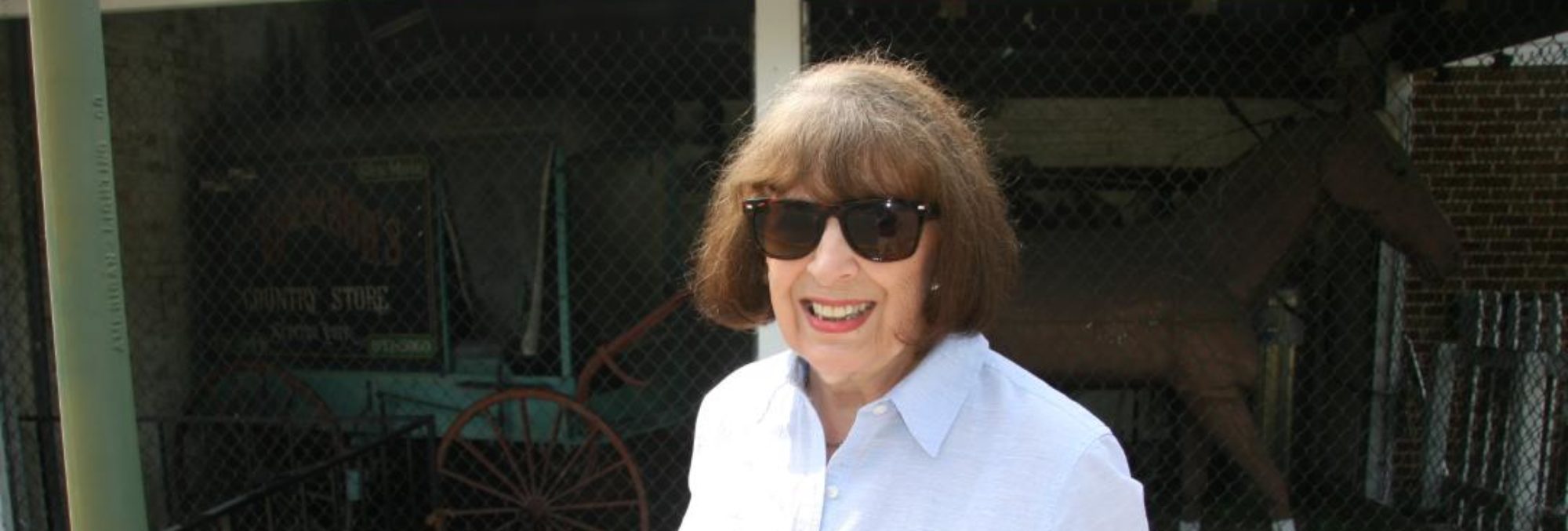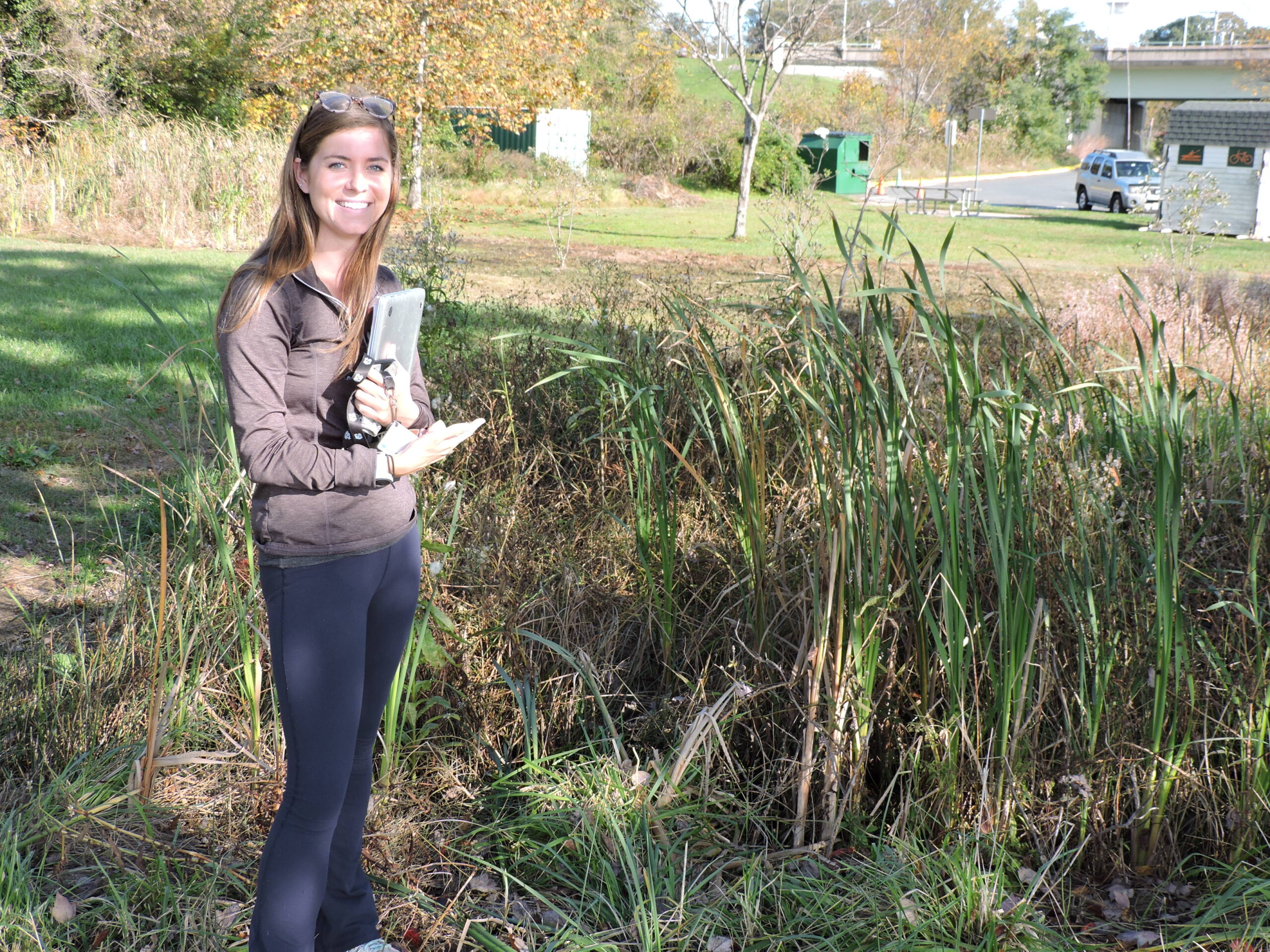AROUND THE PARK AGAIN by Sharon Lee Tegler
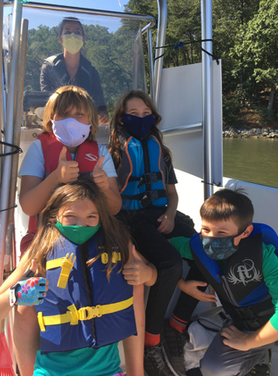
Conducting a Floating Classroom aboard a 20-ft. maritime skiff called Sea Girl on a beautiful late October morning was fun for Emi McGeady. She enjoyed teaching students how oxygen and salinity levels – which the kids measured – affected oyster habitat, oyster restoration efforts, dead zones and wildlife dependent on the river.
“Back in the field” at Jonas and Anne Catherine Green Park at Greenbury Point, McGeady reverted to her role as the Severn River Association’s new field investigator.
Her primary task is running the organization’s water quality monitoring program. Owing to above-average rainfall, algae blooms, and fish kills this year, the testing program took on added importance.
“Every week, I go out with volunteers on our skiff from Back Creek to 44 monitoring stations – 11 along the mainstem of the river and 33 in the Severn’s creeks and coves. We monitor all the way from headwaters at Indian Landing down to Whitehall Bay and Lake Ogleton,” she said.
The monitoring stations are spread across approximately 3,650 acres so it’s impossible to monitor them all in one trip. Thus, they split them into four manageable tours. Because of COVID regulations, only four volunteers go out at a time and everyone must wear a mask. SRA continues to need volunteers of all ages – who needn’t be members – to perform this important task.
“Each tour takes us two to three hours. The shortest tour is six stations and the lengthiest 11 sations,” said McGeady. “At each station, we lower a YSI probe with computerized instrumentation over the side of the boat on a long cord…. as much as eight meters down to just above the bottom though each station is different. The instruments provide a profile of conditions from the bottom to the surface.”
What SRA is most interested in are readings taken from just above the bottom of the river where the oxygen is lowest. It’s also the area where oysters, crabs and other aquatic lifeforms live.
The instrument readings include water temperature, salinity, PH and percentage of dissolved oxygen. A Secchi disk, a 12-inch disk lowered into the water until no longer visible, is used to determine water clarity. Weather conditions, including wind, are also recorded. McGeady uploads all the data they collect to the Chesapeake Monitoring Cooperative.
This summer’s heavy rains resulted in a lot of runoff with bacteria and nutrients entering the water resulting in algae blooms and a mahogany tide when the algae died, decomposed and depleted oxygen levels. This caused dead zones near the river’s bottom.
There was also a large-scale fish kill resulting from Tropical Storm Isaiah churning up the waters and depleting oxygen before the fish could swim away. Approximately 2,000 to 3,000 menhaden died at Sullivan’s Cove in Round Bay and another 7,500 near the mouth of the Severn at Lake Ogelton.
Based on her daily research, McGeady feels SRA’s oyster restoration project is invaluable. Every week, she and several volunteers visit each of five oyster reefs inspected by SRA to make sure oxygen levels, salinity, PH, and temperature readings are sufficient to allow the oysters to grow.
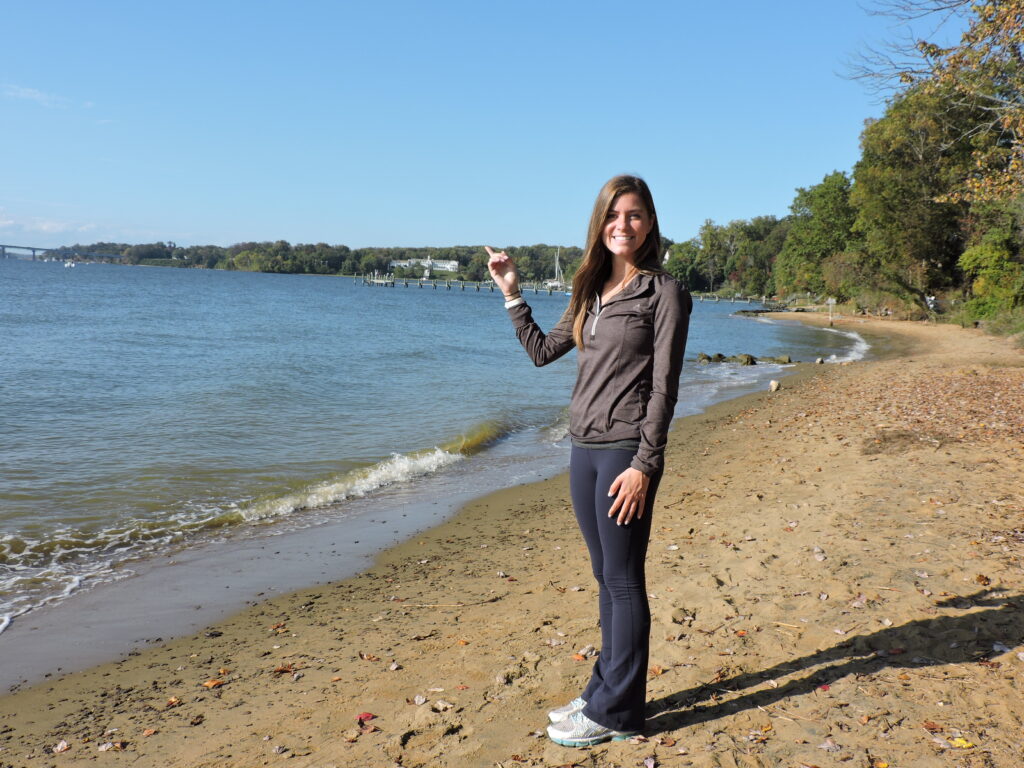
Standing at the park’s shoreline, she explained that all of the oyster reefs SRA monitors in partnership with the Maryland Department of Natural Resources and the Oyster Restoration Project are located between the two Severn River Bridges.
“There were four historic places on the Severn River, dating back to 1911, that had naturally occurring populations of oysters,” she said. “Unfortunately, they were over harvested and completely disappeared. In 2008, the U.S. Army Corp of Engineers came in and prepped all four of those sites using concrete slabs to create artificial structures protruding from the mud on the bottom that oysters could cling to. (Oysters can’t live in mud.)
Two of the four sites were Weems Creek and Weems Upper on the southern shore near the Rt. 50 Severn River Bridge. Another was directly in front of Manressa. The fourth was opposite the hilly area above Manressa known as Peach Orchard.
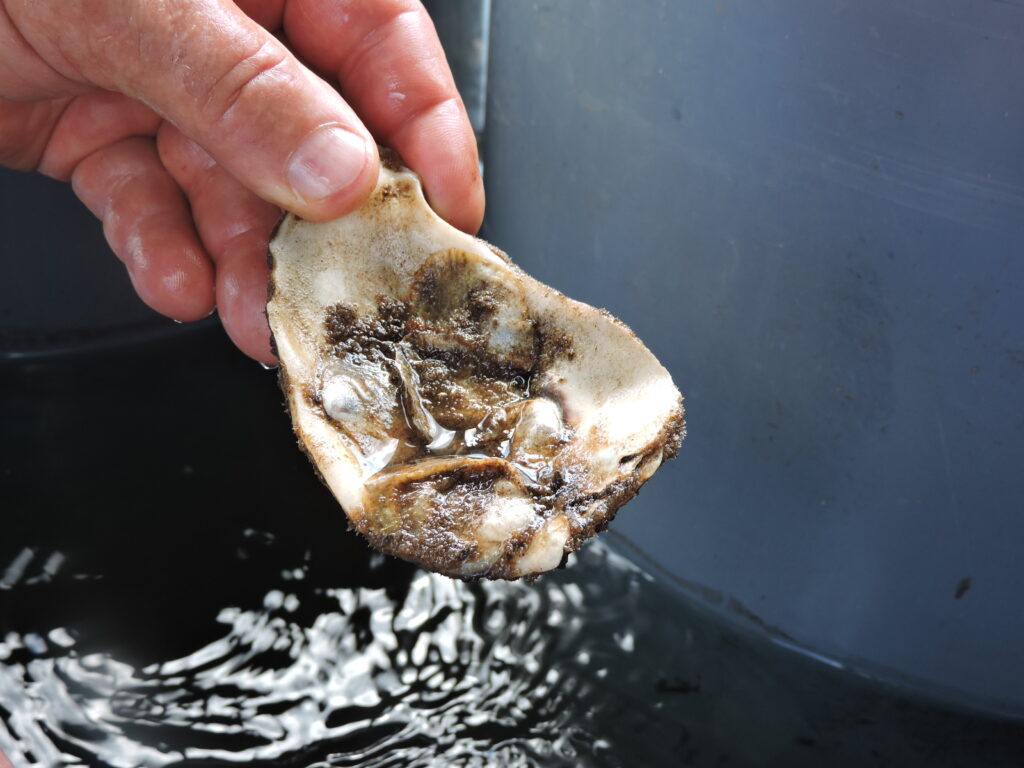
In 2018, SRA’s “Operation Build A Reef” program partnered with the Oyster Recovery Partnership to raise $50,000 in private donations and plant three of the four sites with 47 million oyster spat-on-shell from the University of Maryland’s Horn Point Hatchery off the Choptank River near Cambridge. (Spat are seed-sized oyster larvae that have metamorphosed onto a hard shell. )
In 2019, a salinity collapse in all Maryland rivers due to high rainfall meant there was too much fresh water and too little salinity off Horn Point to produce and provide enough spat for another reef to be filled.
Miraculously, the previously planted oysters survived the collapse and donations kept coming toward a 2020 planting. In July, SRA used those donations to plant 16.9 million baby oysters on the Weems Creek Reef.
Through a program begun in 2009 called Marylanders for Oysters (whereby volunteers grow oysters in cages off their piers) SRA planted oysters on their reef downriver from the Rt. 50 Bridge at Trace’s Hollow which it’s maintained for 11 years.

SRA also partners with DNR and ORP to plant oysters on Wade reef. Now the organization is looking for additional clear water areas suitable for reefs. One possibility is a part of Round Bay called Eagle’s Nest which, though shallow, has clear water and high oxygen levels.
According to McGeady, the Severn River is designated a “sanctuary river for oysters” and none can be harvested.
Some spat die off before maturing, but many oysters live for years. A mature oyster can filter up to 50 gallons of water daily. It would take 10 billion living oysters to sufficiently clean the river and make it healthy.
Oyster reefs provide a great habitat for other marine life including worms, crabs, fish and underwater grasses. Submerged grasses also filter water and dampen wave energy. McGeady monitors aquatic vegetation along with trees and plants onshore that prevent runoff and erosion.
In fact, a clump of earth dislodged from the riverbank caught her eye. Examining it, she found the clump contained phragmites, a non-native invasive species of reeds that crowds out native species animals depend on. She further investigated, spotting phragmite reeds among the native grasses .
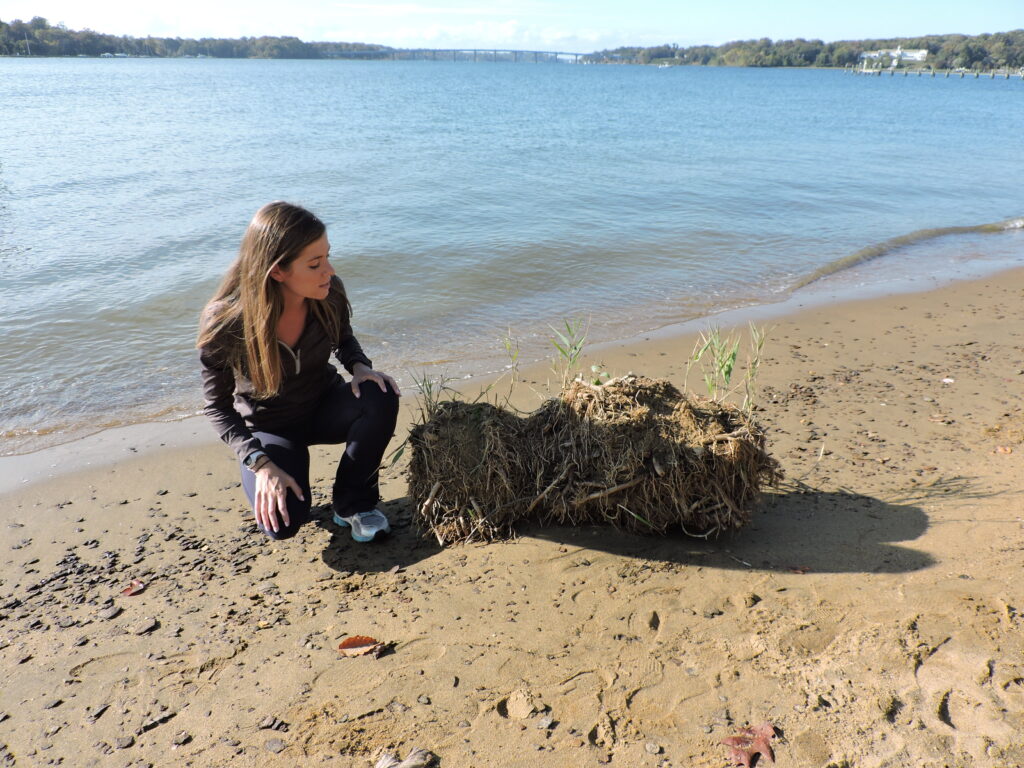
A clump of non-native, invasive phragmites caught McGeady’s eye…… 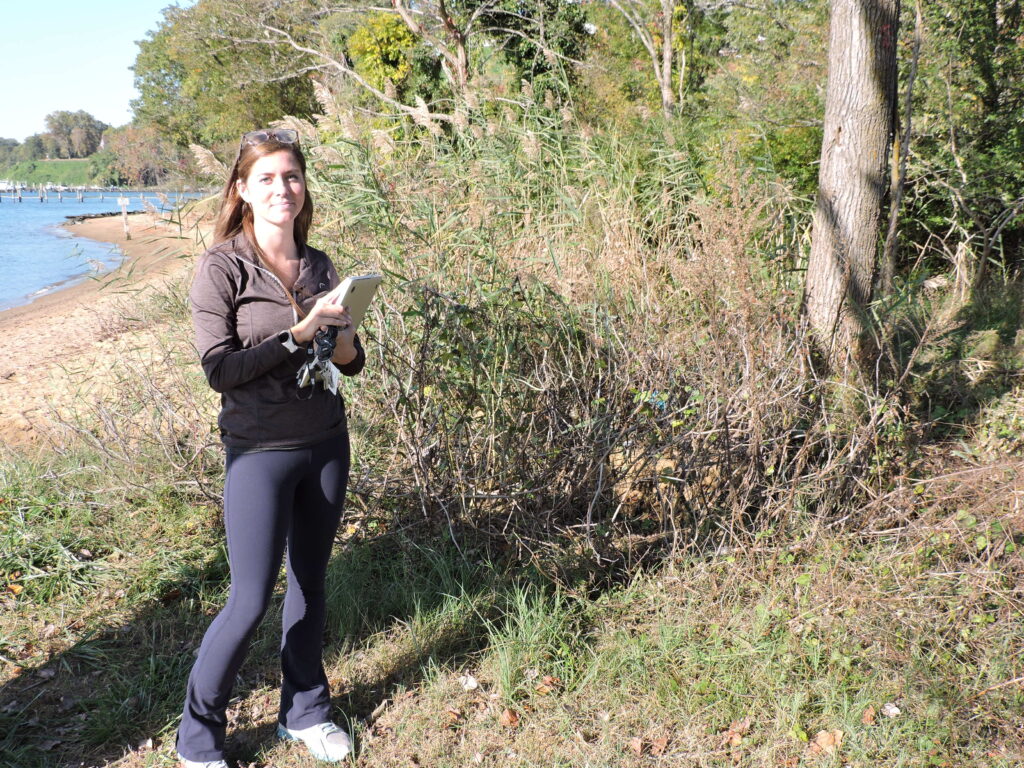
Investigatigating further up the riverbank, she spotted the fluffy seed heads of several of the reed-like plants .
Emi McGeady loves her job as a field investigator. She’s always enjoyed being outdoors. especially at her grandfathers house in the woods of North Carolina. Having grown up in Chartwell, she attended Severna Park High School where she found teacher Sue Hannah’s AP environmental science class fascinating.
After graduating, she attended the University of North Carolina with the idea of becoming a veterinarian. She, instead, fell in love with the school’s environmental science classes, switched her major and had lots of great hands-on experience.
“I went shark tagging, did a reforestation research project in Kentucky, and did research using drones, “she said. “I really enjoyed marine biology, so I thought the best place to apply my knowledge and talents was the Chesapeake Bay.”
She subsequently joined the Chesapeake Conservation Corp of the Chesapeake Bay Trust. The conservation corp provides grants for its members to work on a restoration or ecological program. SRA’s Executive Director Tom Guay had applied for the program on behalf of the organization. The two seemed a perfect match and McGeady’s Chesapeake Conservation Corps grant enabled her to join Guay at SRA in August.
SRA recently elected Erik Kreifeldt as its new president and acquired a new development director Suzanne Martin to lead its fundraising, event and development efforts. For information on the Severn River Association, visit https://severnriver.org/.
Severn River Lions traditional fruit sales are back
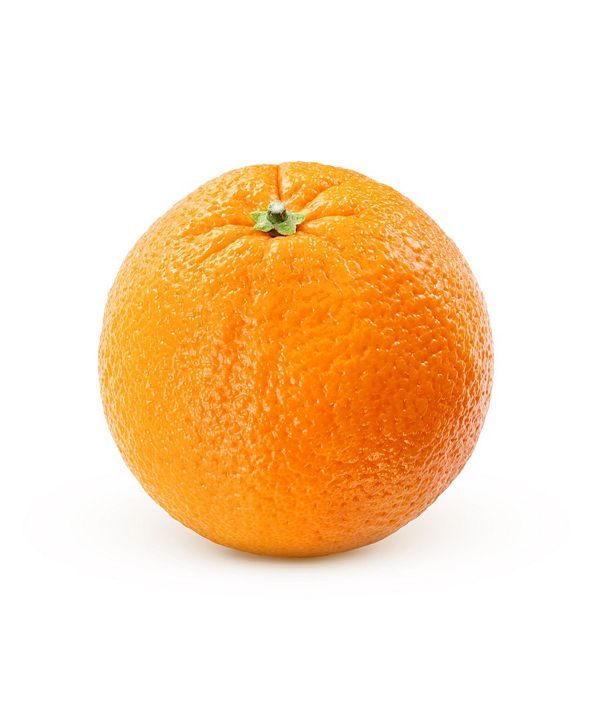
The Severn River Lions are holding their first fruit benefit sale. But this year they are having customers pick up their orders at Cypress Creek Park off Cypress Creek Road on Saturday, November 21.
Florida Navel Oranges, Ruby Red Grapefruit and Mandarin Oranges are being featured. Prices and quantities are listed and orders may be placed online and pre-paid by credit card at SRLCFruit.com, https://shop.floridaindianrivergroves.com/ecommerce/1014813.
Orders must be placed by Friday, Nov. 13. Pick-up on Saturday, November 21 is between 9 a.m. and 1 p.m. Fruit purchased may be delivered direct to the customer but there is a delivery charge of $6.95 per box ordered.
Customers are asked to wear a mask for pickup and should bring their email receipt. For questions, please email fruitorders@severnriverlions.org or call 410-518-9863.
Your purchase helps the Lions support: hearing and vision programs, youth programs, Meals on Wheels, SPAN, Cub and Boy Scouts, the Severna Park Middle School LEO club, Teen Court, children’s eye screenings at elementary schools and other projects.
